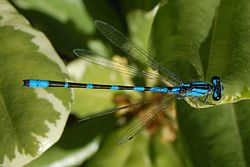| Arroyo bluet | |
|---|---|
 | |
| Scientific classification | |
| Kingdom: | Animalia |
| Phylum: | Arthropoda |
| Class: | Insecta |
| Order: | Odonata |
| Suborder: | Zygoptera |
| Family: | Coenagrionidae |
| Genus: | Enallagma |
| Species: | E. praevarum |
| Binomial name | |
| Enallagma praevarum (Hagen, 1861) | |
The arroyo bluet (Enallagma praevarum) is a damselfly of the family Coenagrionidae, native to the western United States, south to southern Mexico. It is associated with slow-flowing streams or lake margins with emergent vegetation. [1]

